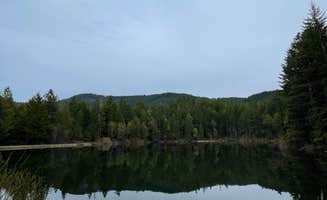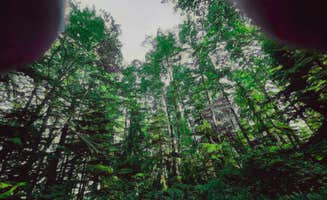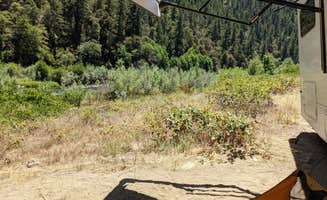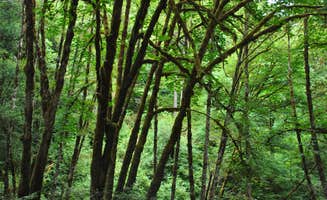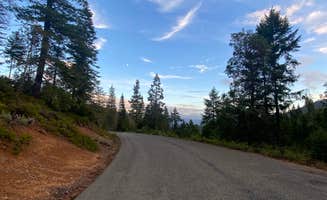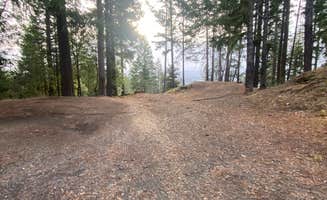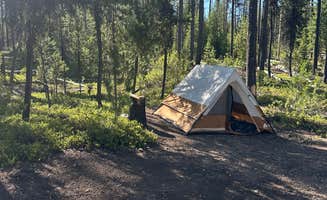Dispersed camping near Myrtle Creek, Oregon occurs primarily at elevations between 1,000-3,000 feet, with summer temperatures averaging 85°F and winter lows near 30°F. The region's volcanic soil supports dense Douglas fir and western hemlock forests that provide natural campsite boundaries at many primitive locations. Camping sites along forest roads typically feature unimproved pull-offs with limited space for larger vehicles.
What to do
Fishing access points: At Ennis Riffle, anglers find multiple entry points to the Rogue River. "The sites are fairly level with mix of sun and shade and stone fire pits and a short walk to the river. Its a nice place to let the dogs run free," notes one visitor to USFS Rogue River Dispersed camping areas.
Swimming in natural pools: Cool off during summer months at small swimming holes near the creekside sites at Elderberry Flats Campground. "There are small swimming holes, lots of crayfish and salmon spawning beds," according to a camper who visited the area's 12 sites, noting that 5 sites sit directly beside Evans Creek.
Wildlife observation: The region offers opportunities to spot native wildlife. At Burma Pond, one camper reported, "Quiet spot not far from I5. No noise at all, just the wind in the trees and bullfrogs... Tons of blackberries growing wild along the waters edge." Another visitor to Rogue River dispersed sites mentioned, "An owl swooped right through our camp site and scared the crap out of us."
What campers like
Solitude and quiet: Many primitive camping areas near Myrtle Creek provide peaceful settings away from crowds. At Burma Pond BLM, one camper noted, "I camped one night right off the water. Quiet and clean. I slept great." Similarly, at Rogue River dispersed sites, a visitor mentioned, "We had to go in a ways before finding a suitable spot, but it was very secluded. We camped near the road but nobody came through the whole night we stayed."
Spacious sites: Despite being primitive, many sites offer ample room. One camper at Elderberry Flats observed that their site was "very spacious; more than enough space for our two tents, two easy-ups, corn hole game, and four vehicles in the driveway with still a lot of space."
River access: Campsites along waterways remain popular for their recreational options. A visitor at Rocky Riffle noted the area has "River access in this area is available in a only few spots that you have to walk to. There is no real shoreline to hang out in unless someone is not camped right in those areas."
What you should know
Road conditions: Forest roads leading to primitive sites often present challenges. At Burma Pond, a camper advised, "The road is a little rough with potholes but it's not terrible if you just drive slow over the holes." Another noted, "Quite a few generally easily dodge-able potholes. Camp sites are very tightly packed and close together. If your vehicle isn't ready for hills or your tires aren't great I would not recommend."
Fire restrictions: Seasonal fire bans typically run June through September. One camper at Rocky Riffle pointed out, "This is a dry camp with no amenities. Tent/car campers welcome but must have port-a-potties. You must pack out your waste and trash... There are NO fires allowed at this time."
Cell service limitations: Communication options are minimal throughout the region. A visitor at Elliott State Forest Dispersed camping areas mentioned, "Needed a last minute to car camp that was close to the coast, found these dispersed sites online and figured it try it out. There was surprisingly multiple spots that I had cell service (AT&T) so I was able to navigate myself around through a satellite map."
Permit requirements: Seasonal regulations apply at certain sites. At Thousand Springs Sno-Park, "Free boon docking during off season (May to October). Otherwise you need a permit (November to April)."
Tips for camping with families
Easily accessible swimming: Locations with gentle water access work best for children. A camper at Elderberry Flats noted, "There are 12 sites with 5 being beside Evans Creek. There are small swimming holes, lots of crayfish and salmon spawning beds."
Safer road options: Some forest roads pose greater challenges than others. One visitor to Thousand Springs Sno-Park observed, "Large, paved parking lot. Plenty of room for big rigs and vault toilets. Some road noise, but nothing that bothered us."
Wildlife education opportunities: Natural settings provide learning experiences. At Burma Pond, one camper reported, "Quiet spot not far from I5. No noise at all, just the wind in the trees and bullfrogs... The fish were jumping and the water clear."
Insect preparedness: Bug protection remains essential during warmer months. One visitor to Thousand Springs Sno-Park advised, "Super buggy bring bug spray, or have a fire going."
Tips from RVers
Suitable vehicle access: Not all dispersed sites accommodate larger vehicles. A visitor to Burma Pond cautioned, "This was quite a way in on a fairly smooth but steep dirt road. Along the road were random deep pot holes so be aware they sneak up on you when the road is shadowed. The last .3 miles was steep and though we made it in 26ft rig I would not attempt it again."
Limited turnaround space: Forest roads often lack adequate turning areas. One camper at Prospect OHV Dispersed Camping noted, "Each cite was very large and moderately away from other campers," making it easier to position larger vehicles.
Leveling challenges: Many primitive sites have uneven terrain. A visitor to USFS Rogue River Dispersed camping explained, "We found several spots easily accessed by our 26ft class c. The road itself is gravel with pot holes but otherwise doable in most rigs."


